Hip thrusts are a go-to for glute constructing, however they aren’t the one train that may allow you to get good points in your higher legs and booty.
Actually, whereas the hip thrust is among the extra well-known glute workout routines, it’s not even essentially the best. And, as a result of it requires a barbell, it’s additionally not probably the most sensible—particularly for anybody who prefers to work out at dwelling.
We reached out to licensed private coach Rachel MacPherson, CPT, for a deeper look into the train—and a few hip thrust options to strive in case you’re seeking to combine up your lower-body exercises.
What’s a barbell hip thrust?
The barbell hip thrust is a energy train that focuses in your gluteus maximus (the most important muscle in your bottom), nevertheless it additionally targets your hamstrings and adductors.
Hip thrusts are an important choice once you’re seeking to strengthen your posterior chain—which is all the bottom of your physique, out of your heels all the best way as much as your head—based on MacPherson.
“The entrance of the physique usually will get extra consideration in coaching routines as a result of they’re what you see within the mirror, and the posterior chain is usually missed, although glute coaching has undoubtedly grown in reputation over the past decade or so,” MacPherson says. “Posterior chain muscle tissue help in sustaining stability, spinal, pelvis, and knee stability, posture, and athletic efficiency.”
Easy methods to a barbell hip thrust with good type
You will want an elevated floor, like a health club bench or field, set to about 16 inches excessive to relaxation your higher again on. Place a barbell over your hips utilizing a barbell sleeve or pad to keep away from ache and bruising.
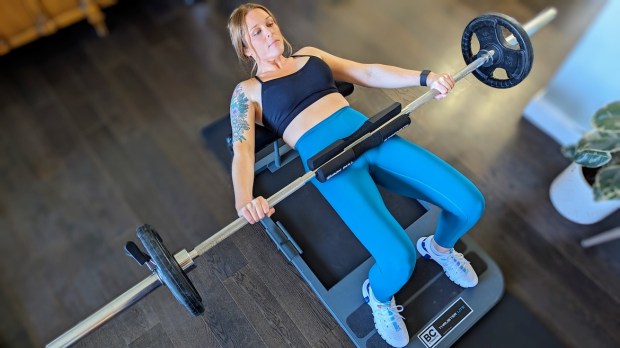
- Sit on the bottom subsequent to a barbell along with your mid again in opposition to the sting of a bench or field. The sting ought to hit you slightly below your shoulder blades.
- Bend your legs about 90 levels and place your toes flat on the ground about hip-width aside.
- Roll the barbell over your legs till it is sitting on the crease of your hips.
- Brace your core, tuck your chin barely, and push via your heels to raise your hips up towards the ceiling. On the high of the motion, you need to be in a straight line out of your shoulders to your knees.
- On the high of the raise, actually squeeze your glutes—that is the principle good thing about the motion, so contract and really feel your glute muscle tissue working.
- Decrease your hips again down slowly and with management to the beginning place.
Maintain your chin tucked and ribs down all through the transfer to keep up a impartial backbone and forestall you from overextending at your neck. Be certain to increase your hips absolutely on the high of the motion to get that peak glute activation. Take into consideration tucking your tailbone underneath as you lock out.
Advantages of the barbell hip thrust
1. It instantly targets your glutes
“Barbell hip thrusts are a direct glute train, and there aren’t too lots of these as a result of most lower-body actions incorporate your quads and hamstrings rather a lot,” MacPherson says. (After all, you do nonetheless make use of some further muscle tissue, however this transfer is closely targeted on the glutes.)
2. It prompts inactive glutes
“Some individuals haven’t had success utilizing squats as a result of they’ll’t really feel their glutes very nicely,” MacPherson says. “Inactive glutes can occur from spending a number of time sitting and never utilizing your glutes sufficient, in order that they basically shut off, and different muscle tissue begin to compensate, which results in muscular imbalances and dysfunction, and ultimately ache.”
3. It prevents ache in every day life
The thrusting motion includes hip extension and exterior rotation, which, in flip, strengthens these muscle tissue. These muscle tissue are a number of the commonest to trigger ache or accidents that individuals are likely to get from operating and even simply every day exercise if their glutes have change into inactive, based on MacPherson.
4. It improves your mind-muscle connection along with your glutes
“Hip thrusts have a peak contraction and sluggish reducing part, which helps you get actually targeted and in tune along with your glutes,” MacPherson says. She notes that this mentality helps you go into all your different glute workout routines with extra connection and subsequently yields higher outcomes.
5. It reduces your threat of damage
“Gluteal muscle operate is tremendous vital for stabilizing the knees, pelvis, and trunk,” MacPherson says. “Sturdy glutes will imply fewer probabilities of ache, damage, and dysfunction in your hips, pelvis, knees, and again.”
Are there downsides to the barbell hip thrust?
Whereas the barbell hip thrust could be a helpful train, there are some downsides which are value noting.
“Hip thrusts are an enormous ache to arrange since you want a strong bench that gained’t transfer, bumper plates to suit your legs beneath the bar, a number of weight to problem such a big muscle group, and a bar pad so that you don’t bruise your pelvis,” MacPherson says.
It’s not simply the tools you need to be cautious of, however that the utmost load in your glutes happens at peak contraction versus within the stretched place. This implies you might not see as a lot muscle progress as you’ll in an train the place the max load is on a stretched muscle, MacPherson says.
If you are going to embrace hip thrusts into your glute exercises, MacPherson recommends together with workout routines like lunges that give a greater muscle stretch and have extra muscle progress potential.
Barbell hip thrust muscle tissue labored
This transfer primarily targets your gluteus maximus, which is definitely made up of two elements: the higher and decrease gluteus maximus. One other hip thrust muscle labored contains your biceps femoris, although much less instantly than your gluteus maximus.
Greatest barbell hip thrust options
Don’t have a barbell at dwelling? Macpherson suggests making an attempt out the next workout routines that work the identical muscle tissue.
1. Single-leg hip thrust with pulse
Utilizing a single leg variation and together with a pulse helps you’re employed the identical muscle tissue with much less load and offers an additional contraction stimulus for each rep as a result of pulse. This variation will also be achieved utilizing a mini band looped round your legs, simply above your knees, and even putting a kettlebell or dumbbell in your pelvis for extra load.
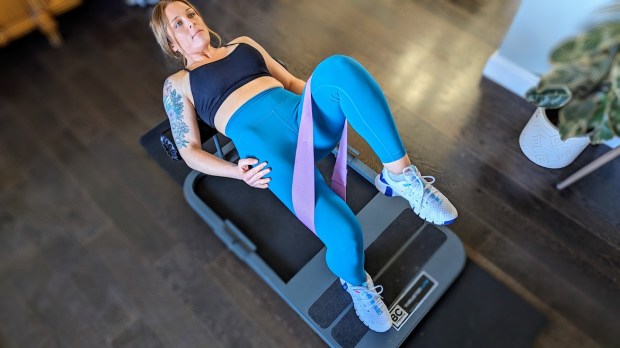
- Sit on the bottom along with your mid again in opposition to the sting of a bench or field. The sting ought to hit you slightly below your shoulder blades.
- If utilizing a mini band, loop it round your legs simply above your knees. If utilizing a weight, maintain it atop your pelvis.
- Bend your legs about 90 levels and place your toes flat on the ground about hip-width aside.
- Brace your core, tuck your chin barely, and raise your left knee towards your chest, elevating your foot from the bottom. Drive your proper heel into the ground, elevating your hips whereas partaking your glutes and hamstrings.
- On the high of the raise, actually squeeze your glutes—that is the principle good thing about the motion, so contract and really feel your glute muscle tissue working.
- Decrease your hips barely, maintain, then press up as excessive as potential earlier than returning to the beginning place.
- Repeat on different aspect.
Be certain your glutes, hamstrings, and core are engaged, and deal with the muscle tissue you might be utilizing. The hip flexor muscle tissue of your supporting leg may even be lively whereas serving to you keep steady, so press that foot into the ground and contract the stationary glute for assist. Maintain your higher again mounted, isolating the motion to your hips, and guarantee one hip stays above the opposite all through the train. A better rep vary of 10 to twenty or so is good for this motion.
2. Facet plank clamshell with hip thrust
This hip thrust variation targets your abductors (the muscle tissue that transfer your thigh away out of your midline), that are in any other case often known as your aspect butt, and builds hip rotator energy.
Working on this frontal airplane of movement works the perimeters of your glutes and hips. It features a hip hinge and hip extension to actually strengthen your glutes.
An enormous good thing about this motion is that it actually helps sort out knee ache as a result of weak hips are the first explanation for many knee points, particularly weak hip abductors and exterior hip rotators, which facilitate knee actions and hold the knee steady.
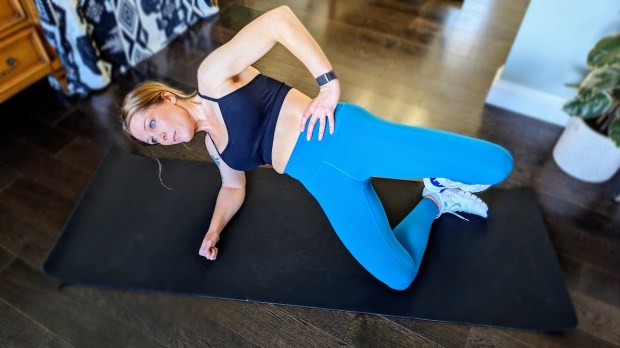
- Lie in your proper aspect along with your toes stacked and your proper elbow underneath your proper shoulder, forearm alongside the ground.
- Bend your knees in order that your toes are behind you.
- Press via your proper forearm and raise your physique up so that you simply’re balancing in your proper forearm and knee.
- Put your left hand in your hip.
- Squeeze your glutes to boost your high knee towards the ceiling.
- Increase your knee as excessive as you possibly can with out letting your pelvis rock ahead or backward.
- Slowly decrease your high knee again to the beginning place.
- Decrease hips right down to the ground.
- Repeat all reps on one aspect earlier than switching to the opposite.
Your glutes and hip muscle tissue ought to be the first muscle tissue engaged throughout this train, however your core and shoulder muscle tissue may even be lively. Be sure you raise your hips off the bottom and rotate your knee upward in a single, easy motion.
3. Strolling lunge
Strolling lunges are a should for any glute-building program. They contain repeatedly shifting ahead with every step, which may actually problem your glutes via a full vary of movement and supply deep muscle engagement and stretch.
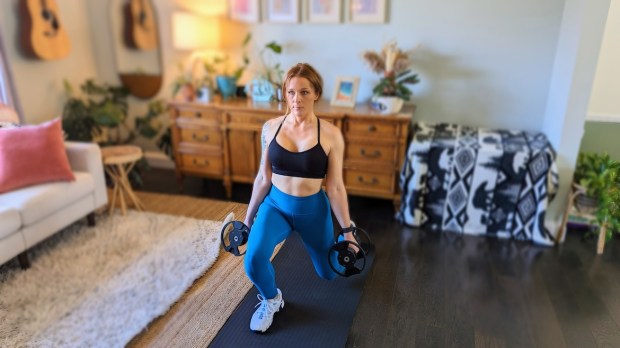
- Stand along with your toes hip-width aside, holding dumbbells by your sides, palms dealing with in towards your physique.
- Take a protracted step ahead along with your proper leg and hold your core engaged. The longer the step, the extra you may interact your glutes. Maintain your torso upright or lean ahead barely—whichever place is most snug for you.
- Decrease your physique towards the ground by bending each knees till your again knee practically touches the bottom. Your entrance thigh ought to be parallel to the bottom and your again knee ought to be aligned underneath your hips.
- Push via the heel of your entrance foot to raise your self again as much as the beginning place.
- Step ahead with the alternative leg and repeat the motion, strolling ahead as you lunge.
Take longer steps to extend the stretch on the glutes of your entrance leg. Concentrate on putting extra weight in your entrance leg, which ought to bear nearly all of the load. Purpose for larger rep ranges (15 to 25 reps) with average to barely heavy weights for this train. You don’t wish to go too heavy or have too few reps since you’ll need the good thing about time underneath pressure in your glutes for higher muscle progress and glute engagement.
4. Reverse lunge
With reverse lunges, you step backward into the lunge as an alternative of ahead, which may cut back stress on the knee whereas nonetheless closely focusing on your glutes.
Reverse lunges are likely to activate your glutes greater than different lunge variations and focus much less in your quadriceps, that are usually extra engaged in conventional ahead lunges.

- Stand along with your toes hip-width aside, holding dumbbells by your sides, palms dealing with in towards your physique.
- Take a big step again along with your foot, putting the ball of that foot on the ground. Step again and barely out to the aspect to maintain stability.
- Bend each knees to decrease your physique towards the ground. Your entrance thigh ought to intention to be parallel to the bottom, and your again knee ought to come near the ground however not contact it.
- Interact your glutes and press via your entrance foot to return your again leg to the beginning place.
- Repeat all reps on one aspect earlier than switching to the opposite.
Be certain your legs keep hip-width aside, not lined up one foot behind the opposite. Taking a bigger step again will increase glute activation by rising the stretch of the glute muscle tissue. Be certain the step is large enough to really feel your glutes interact however nonetheless keep your stability and type.
5. Entrance-foot-elevated lunge
Elevating your entrance foot will increase the vary of motions, stretch, and activation of the glutes on the elevated leg. The upper the platform, the better the stretch and problem for the glutes. (However hold it protected and don’t go too excessive that you may’t deal with the motion and the glute activation!)
A platform a couple of inches to a foot off the bottom is good, however use a top that works for you (relying in your degree of flexibility, leg size, and luxury).
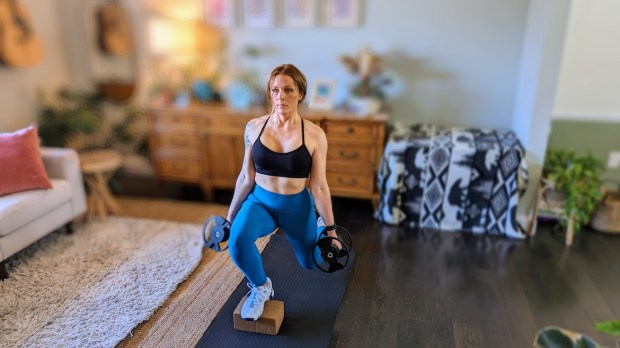
- Place a sturdy step or platform in entrance of you.
- Stand in entrance of the platform along with your toes hip-width aside, holding dumbbells by your sides, palms dealing with in towards your physique.
- Step your proper foot onto the platform, preserving your again foot on the bottom.
- Shift your weight ahead onto your entrance leg and bend your entrance knee, reducing your physique down whereas preserving your again straight and your chest up.
- Proceed reducing till your again knee virtually touches the bottom (or faucet the bottom if it is snug). Maintain your entrance knee aligned along with your ankle.
- Push via the heel of your entrance foot, contracting your glutes to boost again as much as the beginning place.
- Repeat all reps on one aspect earlier than switching to the opposite.
It’s completely nice in your entrance knee to trace over your toes if that’s what works in your anatomy. Concentrate on utilizing your entrance leg to do many of the work. Attempt to decrease the push out of your again foot, apart from balancing. Think about feeling the glutes of your entrance leg all through the motion. The deeper you go within the lunge, the extra you possibly can activate the glutes, however do not pressure your knee or hip by overdoing it.
FAQ
1. Can I construct glutes with out hip thrusts?
Sure, there are numerous different workout routines that work your glutes—a few of which can even be more practical for muscle constructing. Test them out above!
2. Can squats change hip thrusts?
If you have already got nicely developed glutes, squats could possibly be a substitute train. However hip thrusts are significantly helpful for growing your mind-muscle connection and activating your glutes, which may help make different glute workout routines more practical.
3. Are hip thrusts crucial in my exercise routine?
Arguably nothing is critical in a exercise routine. However it may be an important choice in case you’re particularly seeking to goal your glutes.





















+ There are no comments
Add yours